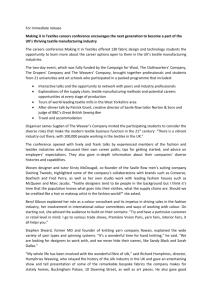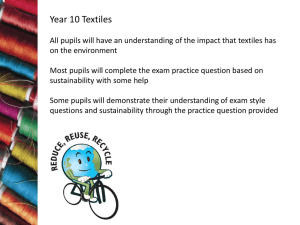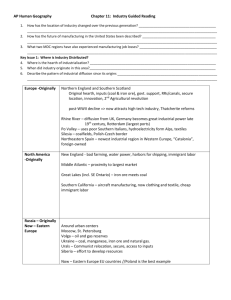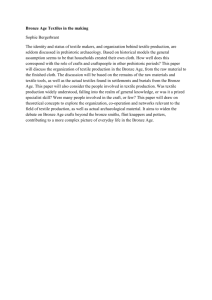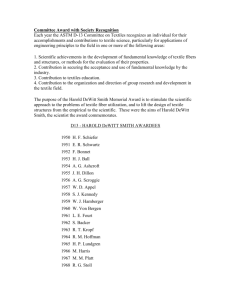HSC Program - Technology Educators Association of NSW
advertisement
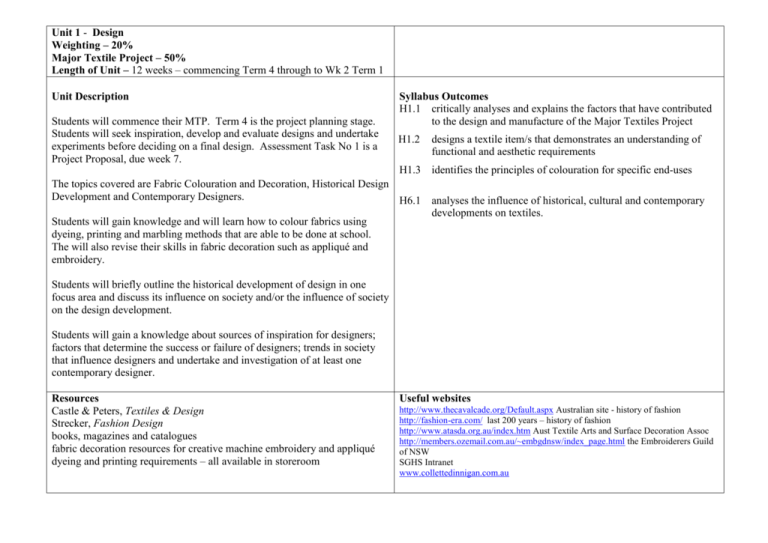
Unit 1 - Design Weighting – 20% Major Textile Project – 50% Length of Unit – 12 weeks – commencing Term 4 through to Wk 2 Term 1 Unit Description Students will commence their MTP. Term 4 is the project planning stage. Students will seek inspiration, develop and evaluate designs and undertake experiments before deciding on a final design. Assessment Task No 1 is a Project Proposal, due week 7. Syllabus Outcomes H1.1 critically analyses and explains the factors that have contributed to the design and manufacture of the Major Textiles Project H1.2 designs a textile item/s that demonstrates an understanding of functional and aesthetic requirements H1.3 identifies the principles of colouration for specific end-uses The topics covered are Fabric Colouration and Decoration, Historical Design Development and Contemporary Designers. H6.1 analyses the influence of historical, cultural and contemporary developments on textiles. Students will gain knowledge and will learn how to colour fabrics using dyeing, printing and marbling methods that are able to be done at school. The will also revise their skills in fabric decoration such as appliqué and embroidery. Students will briefly outline the historical development of design in one focus area and discuss its influence on society and/or the influence of society on the design development. Students will gain a knowledge about sources of inspiration for designers; factors that determine the success or failure of designers; trends in society that influence designers and undertake and investigation of at least one contemporary designer. Resources Castle & Peters, Textiles & Design Strecker, Fashion Design books, magazines and catalogues fabric decoration resources for creative machine embroidery and appliqué dyeing and printing requirements – all available in storeroom Useful websites http://www.thecavalcade.org/Default.aspx Australian site - history of fashion http://fashion-era.com/ last 200 years – history of fashion http://www.atasda.org.au/index.htm Aust Textile Arts and Surface Decoration Assoc http://members.ozemail.com.au/~embgdnsw/index_page.html the Embroiderers Guild of NSW SGHS Intranet www.collettedinnigan.com.au Term 4 - Content Students learn about: Fabric colouration and decoration principles of applying colour to fabrics methods of fabric decoration, including printing, dyeing, appliqué and embroidery Historical design development overview of design developments in society through the focus area - apparel Contemporary designers sources of inspiration for designers factors that determine the success or failure of designers: – external factors, including economic, political, social, ecological and technological – internal factors, including expertise, facilities and financial trends in society that influence: – apparel designers – interior designers – costume designers – textile art designers – non-apparel designers Students learn to: Teaching / Learning Strategies and Assessment investigate, through experimentation, the principles of dyeing, printing, appliqué and embroidery Information from Castle & Peters and Strecker select and apply appropriate methods of fabric colouration and decoration for a specific end-use Teacher guided practical lessons to develop skills in fibre, yarn and fabric dyeing, marbling and screen printing, appliqué and embroidery. briefly outline the historical development of the selected focus area – apparel and discuss its influence on society and/or the influence of society on the design development Teacher may decide on specific case study eg. apparel silhouette changes from 1900 to 1970 or development of the swimming costume. undertake an investigation of at least one contemporary designer, analysing the influences that: – the designer has on trends, and/or – trends have on the designer. Information from Castle & Peters and Strecker on sources of inspiration. Teacher led exercises on developing designs from different forms of inspiration – these exercises will be undertaken during the development of the MTP as well. Students will learn about the factors that determine success or failure of designers and examine trends in society before undertaking a case study of a contemporary designer eg. Collette Dinnigan case study on SGHS Intranet. Major Textile Project the project is to be selected from ONE of the following focus areas: – apparel – furnishings – costume – textile arts – non-apparel Design inspiration including: relevance to focus area justification of creative and/or innovative design relationship to historical, cultural or contemporary factors communication techniques analyse significant cultural/ historical and contemporary influences communicate the justification of creative and/or innovative design Visual design development inspiration, development and evaluation of design ideas functional and aesthetic design explain the relationship between the Major Textiles Project and the selected focus area It is expected that 50% of class time will be devoted to developing the MTP. Throughout Term 4 students will seek inspiration and develop design ideas across a range of focus areas. Students will evaluate designs before deciding on a focus area, then develop more design ideas. The Final Design should be decided by Week 5, so that they may commence Assessment Task 1 which is a MTP Project Proposal. The Project Proposal will address their Inspiration, Final Design, Experiments and Investigations to be undertaken and an Action Plan. They will also address the communication techniques they intend to you eg. folio size, paper, font, creating collages, tables, flowcharts etc… research, analyse and visually communicate appropriate design ideas for the Major Textiles Project Assessment Task 1 – MTP Project Proposal Due – Week 7 Unit 2 - Properties & Performance of Textiles (Part 1) Weighting – 20% Major Textile Project – 50% Length of Unit - 4 weeks in Term 1 Unit Description In the Preliminary course students learned about the properties of fibres, yarns and fabrics. In this topic – End-use Applications, the students will extend their knowledge to include finishes, then apply that knowledge to determine the most suitable end-use applications of textiles in all the focus areas. Syllabus Outcomes H3.1 explains the interrelationship between fabric, yarn and fibre properties H4.1 justifies the selection of fabric, yarn, fibre and fabric finishing techniques for specific end-uses Students should be able to recognise a wide variety of textiles and know how to utilise experiments that would help determine fibre content and fabric properties. In their MTP, students undertake an investigation of the fibre content, yarn and fabric structure and fabric properties of the major textiles use. In the early weeks of Term 1 students should complete these experiments before commencing production of their project. Students should also experiment with manufacturing techniques. If possible, a toile of the MTP should be made before commencing the project, so that final pattern alterations can be made. Resources Castle & Peters, Textiles & Design Gohl & Vilensky, Textiles for Modern Living information on SGHS Intranet fabric, yarn and fibre samples Useful websites http://www.cottonaustralia.com.au Cotton Australia http://www.wool.com/index.php Australian Woolmark http://www.fiberworld.com/ man made fibres http://www.fabriclink.com/home.html Fabric Link http://www.lycra.com/ Lycra Term 1 - Content Students learn about: End-use applications the influences of fabric, yarn and fibre properties and fabric finishes on the selection of textile end-uses in each of the focus areas: apparel, furnishings, costume, textile arts, non-apparel Teaching / Learning Strategies and Assessment analyse and evaluate the functional criteria for items from one focus area to determine the contributing fabric, yarn and fibre properties and fabric finishes eg. furnishings Revise fibre, yarn and fabric properties and testing techniques. Information sourced from Castle & Peters, the SGHS Intranet & recommended weblinks on finishing techniques to enhance fabric performance, including soil-resistant finishes and finishing techniques for a special purpose, such as fire retardant finishes. Students to describe the major fibre, yarn and fabric properties and appropriate finishing techniques for a range of furnishing fabric samples. Major Textile Project Investigation, experimentation and evaluation investigate and experiment with materials, equipment and manufacturing processes for materials, equipment and manufacturing the production of a Major Textiles Project processes selection of appropriate fabric, yarn and make effective decisions based on the fibre application of knowledge evaluate and document the properties and performance of the fabric/s, yarn/s and fibre/s selected for the Major Textiles Project Students are to return to school after the summer holidays with their fabrics ready to commence investigation work and experiment with manufacturing techniques. Students will be following their own Action Plan and submitting sections of their support document to teacher as per teacher’s plan. Students are to commence production of actual MTP item by week 5. Assessment Task No 2 – examination covering MTP inspiration and design development, Design topics covered and End-use applications topic Unit 3 – Design Weighting – 20% Major Textile Project – 50% Length of Unit – 2 weeks Unit Description After the Term 1 assessment period, the students will complete the last Design topic - Cultural factors that influence Design and Designers. The students will gain a knowledge and understanding of the strong link between culture and textile art forms and textiles. They will complete an investigation of one culture and analyse the factors influencing its textile design eg. Scottish tartans, Indian saris, Japanese kimono, Javanese batik. Syllabus Outcomes A student: H2.2 demonstrates proficiency in the manufacture of a textile item/s H2.3 effectively manages the design and manufacture of a Major Textiles Project to completion H6.1 analyses the influence of historical, cultural and contemporary developments on textiles Students will be at the production stage of their MTP and completing each section of the Supporting Document as per the teacher’s plan Resources Castle & Peters, Textiles & Design Strecker – Fashion Design Information on SGHS Intranet books, magazines and websites Useful websites www.style.com contemporary fashion site Content The students learn about: Cultural factors that influence design and designers textile production and textile art forms textiles as a medium for self-expression and communication between people effects of the culture on textile design in contemporary society external factors that have influenced textile design ie. economic, political, social and ecological cultural influences, including geographic location, resources available and technological developments, religious practices, workers’ skills and status The students learn to: Major Textile Project At this time students are involved in the production of their textile item and completing each section of the Supporting Document as per the teacher’s plan Suggested Teaching / Learning Strategies and Assessment identify textile production and textile art forms from different cultures identify examples of textile design used for self-expression and communication between people identify examples of how culture affects contemporary textile design analyse the external factors influencing textile design analyses how cultural factors such as geographic location and resources available etc… led to the development of textile design in different cultures Information sourced from Castle & Peters, the SGHS Intranet investigate ONE culture and analyse the factors influencing its textile design Students will undertake an investigation of one culture and analyse the factors influencing its textile design eg. Scottish tartan, Japanese kimono. This topic requires that the students have a good knowledge of lots of examples of textiles from different cultures and that they are able to analyse the cultural influences on contemporary textiles. Make extensive use of magazines, books and the Internet to find examples. Unit 4 - Properties and Performance of Textiles (Part 2) Weighting – 20% Major Textile Project – 50% Length of Unit – 6 weeks Unit Description This area of study allows students to develop knowledge and understanding of scientific and technological developments in the textiles industry. Students will gain knowledge about developments in fibre, yarn, fabric and finishes technology; computer based machinery that saves time and costs and fabric decoration techniques. The student should be able to evaluate the impact of these developments on the textiles industry and list advantages and disadvantages to the consumer, manufacturer, employee and the environment. Syllabus Outcomes The student: H3.2 develops knowledge and awareness of emerging textile technologies The students will complete the textiles item for their MTP by the end of Term 2. At this stage the students should be documenting the Manufacturing Specifications section of the Supporting Document. Resources Castle & Peters, Textiles & Design SGHS Intranet Useful websites http://www.fibersource.com/f-tutor/micro.htm microfibre http://www.fibersource.com/f-tutor/bicomponent.htm bicomponent fibres Content Students learn about: Students learn to: Teaching / Learning Strategies and Assessment Innovations and emerging textile technologies innovations and technological advances in: i) the use of textiles to enhance performance – fibre, including microfibre – yarn, including bicomponent – fabric, including washable webs ii) machinery to improve construction or save time, including computer-linked machines, computer-aided design (CAD) and computer-aided manufacture (CAM) iii) decorative techniques to enhance design, including digital printing Information from Castle & Peters, SGHS Intranet and websites Videos on CAD/CAM systems investigate and use, as appropriate, a range of innovative advances in textile materials and techniques evaluate the impact of technological advances in machinery on the changing nature of the industry investigate TWO innovations in finishing techniques to determine their impact on fabric performance iv) finishing techniques to enhance fabric performance, including soil-resistant finishes and finishing techniques for a special purpose, such as fire retardant finishes the advantages and disadvantages of innovations and related textile technologies on: – the consumer – the manufacturer – the employee – the environment identify and discuss areas of textile production that utilise new textile technologies investigate an innovation in fabric development, yarn development and fibre development and the impact of each on society and the environment Besides gaining knowledge about the emerging and innovative technologies, students should be evaluating the impact of each on the various stakeholders in the textile industry and on our environment. Major Textile Project Manufacturing specification including: description – written description, pattern company and pattern number (if applicable) production drawings – front and back views, pattern shapes and pattern markings technical production plans – fabric swatches, quantity of material, notions required, itemised cost, total cost, order of construction product label – legal requirements, including care instructions, fibre content, size, country of manufacture, brand name develop and produce manufacturing specifications for the Major Textiles Project manage time effectively in the completion of a quality Major Textiles Project design and produce a label/s suitable for the Major Textiles Project item/s Students should be documenting the manufacturing specifications section of the Supporting Document. Assessment Task 3 – Oral presentation of investigation and experimentation section of Supporting Document Unit 5 – Australian Textile, Clothing, Footwear and Allied Industry Weighting – 10% Major Textile Project – 50% Length of Unit – 8 weeks Unit Description Studies in this area will enable students to make decisions about factors affecting the consumer, producer, manufacturer and retailer. The Marketplace topic should be completed before the end of Term 2. The Appropriate Textile Technology and Environmental Sustainability topic should be completed at the beginning of Term 3 before the Trial HSC examination. The Current Issues topic is completed after the Trial HSC. Syllabus Outcomes The student: H5.1 investigates and describes aspects of marketing in the textile industry H5.2 analyses and discusses the impact of current issues on the Australian textiles industry H6.1 analyses the influence of historical, cultural and contemporary developments of textiles. Each of these topics requires the students to make evaluations and be able to discuss and debate impacts on society and the environment The production of the MTP textile item should be completed at the end of Term 2. Students should use the holiday time to complete their Supporting Document. The completed project is handed in Monday of week 2 ready for photographing, and parading on assembly, packing and completing certification well before the commencement of the Trial HSC exams. Resources Castle & Peters, Textiles & Design Strecker, Fashion Design various ClickView videos – How Green are my Jeans SGHS Intranet Useful websites http://www.peteralexander.com.au/ Peter Alexander site http://www.sussan.com.au/home.asp Sussans site http://www.kmart.com.au/ K Mart site http://www.demi.org.uk sustainable design http://www.cfd.rmit.edu.au/sustainable_products/erd_guidelines_textiles RMIT sustainable design in textiles http://eartheasy.com/wear_ecospun.htm Ecospun - fibre recycled from PET bottles Term 4 - Content Students learn about: Marketplace aspects of marketing of textile products, including: – product planning – place and distribution channels – price structure – promotion strategies product life cycle target markets Appropriate textile technology and environmental sustainability selection of appropriate technology in the industry – resources, alternatives and limitations appropriate and sustainable textile resources – recycling – pollution – government legislation Current issues current issues that affect the industry, including: – globalisation of design, manufacture, distribution and marketing – imports/exports – skill level of workers – changing consumer demands and lifestyle: sun protection factor clothing, clothing made from organic sources – manufacturing strategies, niche and mass-produced good Students learn to: Teaching / Learning Strategies and Assessment compare TWO different product marketing strategies for ONE aspect of a focus area (apparel, furnishings, costume, textile arts, non-apparel) and explain why they are appropriate for a specific textile product Information from Castle & Peters and Strecker discuss how the selection of resources and processes will impact upon the environment Refer to SGHS Intranet for links to legislation, information on LCA, environmental concerns and solutions. identify the problems of pollution and recycling of materials associated with the industry evaluate the impact of government legislation on the industry complete a Life Cycle Assessment of an Australian cotton T shirt investigate and debate a range of issues that impact upon the Australian Textile, Clothing, Footwear and Allied Industries Refer to SGHS Intranet for case study – Marketing pyjamas through Peter Alexander, Sussans and K Mart. Students should be able to discuss and debate issues seeing that there are no black and white answers to the many environmental impacts caused by the textiles industry. Assessment Task 4 – Trial HSC examination Refer to information on SGHS Intranet. Students should be able to discuss the pros and cons of current issues especially how the textile industry is surviving in Australia in the face of the industry restructuring, the globalisation of the textiles industry and changing consumer demands. Students should be able to name and describe Australian textile items that are mass produced as against niche products.

